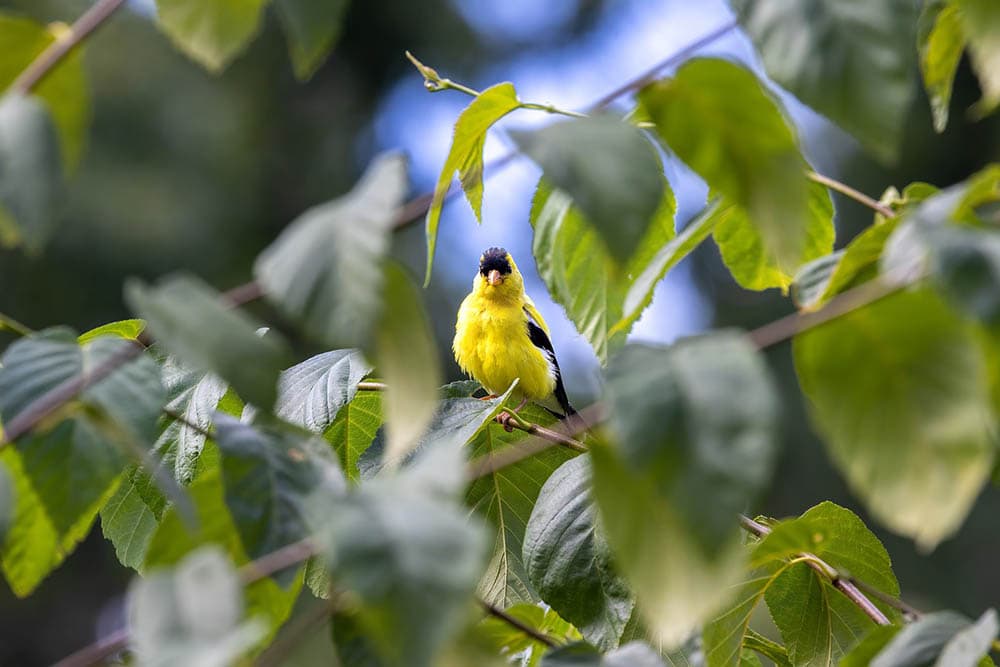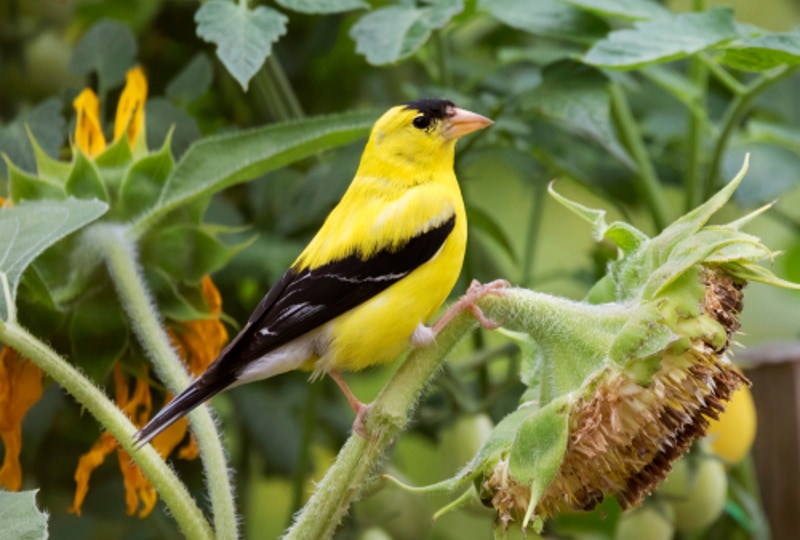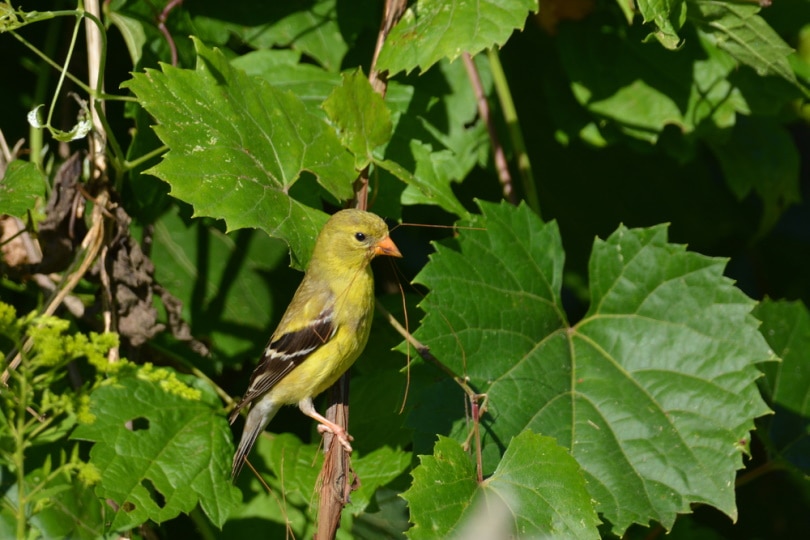What Is Iowa’s State Bird? How Was It Decided?
Last Updated on

Iowa’s state bird is the Eastern Goldfinch. However, some sources refer to it as the American Goldfinch because it is a subspecies in that family. Nonetheless, this is a very special bird, as you’ll come to learn.
It has a rich history, fascinating facts, and so much to offer to our ecosystem. The people of Iowa already knew this, and that is why they decided to settle on the bird, in 1933, to be the state representative.
Before we get ahead of ourselves, let’s just start by defining what a state bird is. It’s any bird chosen by the legislature to act as an emblem and represent the values of a community. So, if the bird doesn’t exude traits such as strength, tenacity, power, or anything that resonates with the people, it cannot qualify to be an emblem of the community.

The Eastern Goldfinch’s Journey to Coronation
It’s no secret that the state of Iowa has its fair share of emblems. We could start by looking at the oak tree as the state tree and not even get to the geode as the state rock by the time the sun goes down.
But what really piqued our interest was realizing that this state didn’t list any bird species to act as their symbol until 1933. It was during that year that the Ornithology Union members decided to finally hold their 10th annual convention meant to discuss and decide which bird species is an appropriate state emblem—that meeting took place in Des Moines.
One of the members of that Union was Representative J. Wilbur Dole. He was the guy who forwarded the nomination to the House of Representatives, where it was adopted. The Senate also gave its stamp of approval eventually, making the Eastern Goldfinch the official symbol of the state.

The Conception of The Idea
What most people don’t know is, that wasn’t the first time the idea of having a state bird was brought up in the Ornithologists Union meeting. There were whispers among the members, and the International Ornithologists Union president at the time, Walter Rosene, drafted a letter on the 6th day of February in 1926 to let everyone know that they already had a list of candidates.
The Western Meadow Lark was part of that list and the most favored among the different species. To ease concerns among members, the letter also assured them that the final decision would not be unilateral. There would be discussions, and official action would only be taken once all the members reached a consensus.
Two months later, Rosene drafted a second letter and mailed it to all the members of the Union. But this time round, he requested all members to come up with other suggestions, so that they could have enough options to work with.
When the replies came back, three birds stood out—the American Goldfinch, the Chickadee, and the Downy Woodpecker. All that remained was for the committee to have a sit-down, further trim down the list, and finally come up with a suitable candidate to pass to the legislature—but they had a different idea.
In 1927, they suggested the final pick should be left in the hands of the school children of Iowa. So when they sat down to comb through the list they had, every member was asked to create a list of five to six birds. The lists were then compiled into one, and the top five were sent to all schools in the state.
The county superintendents were then tasked with distributing the lists in all schools within their territorial jurisdiction and relaying the instructions as discussed by the committee. Because the 21st day of March was designated as a Bird Day in Iowa, they felt it was only right for the kids to cast their votes on that day.
Once the children are done voting, everything would be counted, and the bird with the most votes gets to be crowned as the state bird of Iowa.
The Setback
We don’t know why, but this plan was never executed. The schools never received any list or even a word from the higher-ups. As a matter of fact, everything went silent for another 5 or so years.
However, that doesn’t mean people forgot they didn’t have a state bird. You can hardly forget such a thing. After a while, members of the International Ornithology Union started whispering again. And this time, they felt that the bird to be chosen should be one that doesn’t migrate. Any bird that was found in the state all year round was a possible candidate.
In 1933, Walter Rosene, Althea Sherman, and most of the members of the organization voted in favor of the Goldfinch. On the 22nd of March that year, the bird was approved by both the house and the senate, becoming the official state bird.

Identifying the Eastern Goldfinch
First off, it’s important to take note of the fact that this species exudes sexual dimorphism. That’s to say, the males and the females have dissimilar traits. And this contrast can be clearly seen during summer, when they are most active, trying to fish for potential mates. In case you’re wondering, summer is when most bird species mate and procreate.
If you spot them during fall, they’ll be sporting an olive-brown plumage. Their underside will be buff-colored, and their faces light yellow. Distinguishing the males from their spouses won’t be easy during that period but if you look closely at the shoulders, you’ll notice that the females don’t come with any yellow patches.
The other feature that we often look at to tell them apart is the coloration of the tail feathers and wings. The males have dark tail features and dark bars on their wings, while the females have brown on both.
The plumage’s color change during summer makes it easier to differentiate the genders. You see, after the spring molt, the male will develop a plumage that’s bright yellow, as their counterparts develop one that’s yellowish-brown. That of the male looks more appealing because it’s meant to grab the attention of a potential mate.
Nesting
The ideal site for a Goldfinch nest is one defined by coniferous or herbaceous shrubs. And more often than not, the nest will be found at the joint of two branches, to ensure it has all the support it needs to not fall. Nesting in dense mature forests is a no-no, as it prefers habitats that are open and support new growth.
Before building the nest, the Goldfinch will look for a spot that’s several feet off the ground. That same spot should provide shelter at the top, and an opening that facilitates free-flowing air underneath.
The last item that they’ll check before starting construction is the availability of resources. They’ll never build a nest unless they are certain that that area has everything they need to breed successfully during that season.
Goldfinches love constructing their nests in small colonies. So if you spot one while you’re out enjoying what nature has to provide, keep looking for others. You’ll probably find more than five in that same area.
They are usually cup-shaped, and sturdy, thanks to the strips of bark and twigs, woven together using spider silk. The interior will have a different look, seeing as it’s primarily made of plant fibers, rootlets, and downy lining.
All the construction work will be handled by the female, as the male stands guard looking out for predators such as weasels, blue jays, and the eastern garter snake. It’s a daunting process for a bird that size, and that’s why it takes 4 to 15 days. Females that are more experienced will only need a few days.

Eggs
The eggs are bluish-white and oval. But sometimes they have faint brown spots. On average, they are 1.24 cm in width and 1.66 cm in length. The bird will lay 2 to 7 eggs depending on the conditions and 1 to 2 broods per season.
From our observation, they mostly have 2 broods per season, if they were unsuccessful the first time. Maybe a predator disrupted the process or food became scarce.
Behavior
Goldfinches are very social in nature. They’ll never provoke or attack anyone unless they feel threatened. They are part of the diurnal species family, meaning they are never active under the cover of darkness.
Their flying technique is unique in the sense that they always look like they are trying to create a wavelike pattern while soaring. You’ll see them dipping and rising instead of taking a straight path.
If the bird is not airborne, it’s probably perched on a pole or tree, preparing to land on the ground. They mainly feed on seeds, berries, forbs, floral buds, and insects.

Frequently Asked Questions
Why is the goldfinch sometimes referred to as the “Wild Canary”?
The name “Wild Canary” is the official moniker of the Atlantic Canary. This is a tiny passerine species that are found in the Fringillidae family of finches. The bird is widespread and can be found anywhere in the world. Some communities simply refer to it as the “Common Canary” or “Island Canary.”
Goldfinches are sometimes called “Wild Canaries” because they are related to the Atlantic Canary. They share most of the same traits and behaviors.
What is Iowa famous for?
Iowa is the United States 29th state, which goes by the nickname the “Hawkeye State.” This is the name Edwards and Rorer gave it, in honor of the Black Hawk. They also felt the name would be an easy sell to the public, thanks to the epic historical drama film The Last of the Mohicans.
Iowa is also famous because it’s the state where the plane crash that killed J.P, Buddy Holly, and Ritchie Valens happened. According to different news agencies, that was the “day music died.” Corn production is also doing well in this state, as well as pig rearing.

Final Thoughts
Iowa’s state bird is the Eastern Goldfinch, and they are huge fans of the bird feeder. Even though they aren’t picky eaters, they love sunflower seeds and thistle more than anything. So if you’re hoping to make them regular visitors, serve them those seeds and replace anything left uneaten after every 3 to 4 weeks. The feeders can either be sock, mesh, or tube designed.
See Also: 5 Types of Hummingbirds in Iowa (With Pictures)
Featured Image Credit: MOHANN, Pixabay
About the Author Robert Sparks
Robert’s obsession with all things optical started early in life, when his optician father would bring home prototypes for Robert to play with. Nowadays, Robert is dedicated to helping others find the right optics for their needs. His hobbies include astronomy, astrophysics, and model building. Originally from Newark, NJ, he resides in Santa Fe, New Mexico, where the nighttime skies are filled with glittering stars.
Related Articles:
What Is the Best Binocular Magnification for Hunting? Optical Features Explained
10 Types of Hummingbirds in Arkansas (With Pictures)
8 Types of Hummingbirds in Nebraska (With Pictures)
5 Types of Hummingbirds in Idaho (With Pictures)
3 Types of Hummingbirds in Mississippi (With Pictures)
8 Types of Hummingbirds in Kansas (With Pictures)
5 Types of Hummingbirds in West Virginia (With Pictures)
5 Types of Hummingbirds in Ohio (With Pictures)
